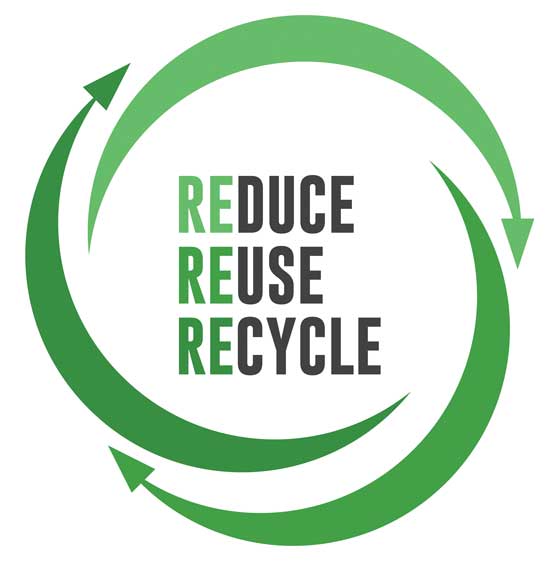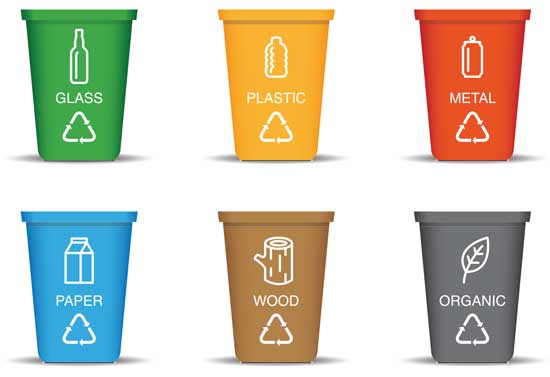How to Reduce Packaging Waste
PACKAGING

The need to combat climate change and to use limited resources wisely drives motivation to reduce packaging waste. There is great potential in achieving a more circular economy that shifts away from a model that consumes more resources and generates surplus waste. And strong reasons exist for both circular and noncircular options. Here are some ways to reduce packaging waste while shifting to a more circular economy.
Toward a Circular Economy
Despite the losses inherent to a circular economy, reducing the production and consumption of virgin-derived packaging materials is a sustainable vision that the packaging industry advocates. To achieve a more circular economy, reducing, reusing, and recycling are needed to divert packaging materials from waste streams. Life cycle assessments (LCAs) sum up the resource and energy consumed from the time raw materials are extracted to produce a package through its final disposal. LCAs provide a full picture of the impacts of packaging on the environment; however, they do not include the protective capacity of packaging to address food waste (Heller et al. 2018). Coca-Cola, Kraft Heinz, McDonald’s, Danone, Nestlé, Unilever, and other food companies have established goals for package recycling. The American Chemistry Council’s plastics division has announced goals for recycling all plastic packaging by 2040. And European plastics manufacturers are also committed to ensuring high rates of reuse and recycling of plastic packaging by 2030.
Collecting and Sorting More Packaging
An increased focus on collection and sorting is needed to enable proper handling of packaging via recycling, reuse, landfilling, composting, degrading, or incinerating. There are many options for proper disposal of post-consumer packaging, yet packaging waste sometimes ends up where it should not be. For example, packaging waste is littered on city streets and flows into oceans. Avio et al. (2017) estimate that almost 10% of the annual production of plastics ends up in the oceans (i.e., about 35 million tons in 2017). This large percentage of plastic packaging in aquatic environments has led to bans on single-use plastic packaging. To address this issue, packaging needs to be properly collected, sorted, and processed. Even though metal and water-sensitive materials such as paperboard rest on ocean bottoms, they are also concerns because they release compounds into the water as they degrade. Clearly, more effective collection and sorting options are needed.
 Consumer participation in the sorting of package waste prior to collection is often viewed to be most efficient and effective. In Japan, where food packaging encompasses 60% of household waste, consumers sort packaging by type and recycling rates are high. In contrast, commingled recycling typically results in about 15% fewer materials being recycled. Because many municipalities do not charge for recycling, nonrecyclable packaging often ends up in recycling bins, making sorting more cumbersome. The packaging industry is working to make sorting less cumbersome for consumers. For example, consumer sorting can be assisted by intelligent packaging that provides disposal directions and by increased use of the Sustainable Packaging Coalition’s How2Recycle label system. With higher collection and sorting rates, a more beneficial circular economy is viable.
Consumer participation in the sorting of package waste prior to collection is often viewed to be most efficient and effective. In Japan, where food packaging encompasses 60% of household waste, consumers sort packaging by type and recycling rates are high. In contrast, commingled recycling typically results in about 15% fewer materials being recycled. Because many municipalities do not charge for recycling, nonrecyclable packaging often ends up in recycling bins, making sorting more cumbersome. The packaging industry is working to make sorting less cumbersome for consumers. For example, consumer sorting can be assisted by intelligent packaging that provides disposal directions and by increased use of the Sustainable Packaging Coalition’s How2Recycle label system. With higher collection and sorting rates, a more beneficial circular economy is viable.
Preventing Packaging Waste
Source reduction prevents packaging from entering into the waste stream and often aligns with the cost savings initiatives of businesses. Source reduction was pursued in response to the 1991 California Rigid Plastic Packaging Container law, which mandated targets for lightweighting of packaging materials. Because of the lightweighting of polyethylene terephthalate (PET) packaging, less PET was collected in 2017. For example, a 500 mL PET water bottle that weighed 28 grams in 1985 now typically weighs 9 grams. In addition, Amazon’s incentive to reduce the amount of packaging consumers receive via e-commerce has fueled new packaging designs; as a result, Amazon’s packaging waste was reduced by 16% in 2017. The company’s more compact packaging has also made product transport more efficient and less energy-intensive.
The environmental impact of not recycling is two-fold in that recyclable materials never realize their usefulness for other purposes and the packages thus require disposal by other means. The high levels of recycling in Germany for PET (94%) and aluminum (99%) are indicative of what is achievable in recycling. However, U.S. and international food-contact regulations limit the use of recycled plastic for food packaging, especially for polyolefins (Geueke et al. 2018). Interestingly, recycling of paper is high. For example, about 80% of paper made in Japan is recycled, and 60% of this is remade into paper. Still, recycling is somewhat hampered by unintended environmental costs and recycling delays, but that does not prevent packaging material from being deemed of zero value (Zink and Geyer 2018). For example, China’s policy shift in 2015 from accepting more than 48 million tons of unsorted plastic to a ban on specific materials and requirements for cleaner polymers was driven by the need to reduce environmental damage associated with packaging waste in China. Much of this environmental damage has been shifted to other countries in the region. LCAs often ignore these environmental impacts. Initiatives to provide more profitable recyclable packaging streams for sorted materials are needed to enable a viable circular economy. Thankfully, innovations in design, material science, and chemical recycling can provide economically effective solutions.
Reuse of direct food-contact packaging has been primarily focused on reusable glass beverage bottles, business-to-business shipping crates, and limited- to closed-loop operations. Packaging reuse does not always guarantee an environmental benefit (Cooper and Gutowski 2017). For example, reusable glass bottles consume energy in their shipments to and from retailers and are heavier than nonreusable glass bottles because they need to be more durable. Innovations in materials science by companies such as Vetropack are promising as they provide strong lightweight glass with laser applied QR codes for ease of tracking. For tertiary packaging, the use of reusable standardized shipping crates and modified atmosphere flexible packaging for distribution has much potential. Concepts from returnable packaging suppliers in areas outside the food industry can be adapted to food applications to divert packaging from waste streams.
Noncircular Waste Disposal Options
Waste disposal options for noncircular packaging waste are landfilling, composting, degrading, and incineration. Landfills are encased in liners to prevent groundwater contamination. In 2015, about 138 million tons of waste were landfilled in the United States, and food waste was the largest component, constituting about 22%. Plastics accounted for about 19%, and paper and paperboard made up about 13% (EPA 2018). The anaerobic decomposition of organic materials in municipal solid waste landfills typically generates methane (which can be captured for energy) and carbon dioxide.
After being composted, some packaging materials can degrade to produce a humus-like substance. Further, there are heightened concerns with degradation products such as microplastics and the use of oxo-degradable additives that are inconsistent with circular systems and not viable to reduce pollution (Bioplastic Feedstock Alliance 2018). Degradation of packaging materials in a controlled environment is more sustainable than ocean-degradable plastics. When polymers such as polylactic acid and polyethylene degrade in the ocean and on land, greenhouse gases are emitted, and this uncontrolled degradation can create unintended environmental consequences even though the byproducts are not visible. And during incineration, waste-to-energy plants burn packaging materials and other waste and generate energy in the process. Generally, regions of the world where populations are dense and land is limited are more likely to incinerate waste due to space constraints. In the United States, about 16 percent of plastics and about 13 percent of paper and paperboard are incinerated (EPA 2018).
Great strides have been made to make packaging more sustainable, but the role of packaging in creating a more sustainable food supply is increasingly acute. As more businesses commit to a circular economy, the need for sustainably packaged food becomes even more essential.
 Claire Koelsch Sand, PhD, Contributing Editor
Claire Koelsch Sand, PhD, Contributing Editor
President, Packaging Technology and Research
Adjunct Professor, Michigan State Univ.
[email protected]
Gordon L. Robertson, PhD, an emeritus member and IFT Fellow, is an adjunct professor, University of Queensland, Australia ([email protected])
References
Bioplastic Feedstock Alliance. 2018. “BFA Position on Oxo-Degradable Additives.” http://bioplasticfeedstockalliance.org/bfa-position-on-oxo-degradable-additives/.
Avio, C. G., S. Gorbi, and F. Regoli. 2018. Plastics and microplastics in the oceans: from emerging pollutants to emerged threat. Mar. Environ. Res. 128: 2–11.
Cooper, D. R. and T. G. Gutowski. 2017. The environmental impacts of reuse: a review. J. Ind. Ecol. 21(1): 38–56.
EPA. 2018. “Facts and Figures About Materials, Waste and Recycling.” www.epa.gov/facts-and-figures-about-materials-waste-and-recycling.
Geueke, B., K. Groh, and J. Muncke. 2018. Food packaging in the circular economy: overview of chemical safety aspects for commonly used materials. J. Clean. Prod. 193: 491–505.
Heller, M., S. Selke, and G. Keoleian. 2018. Mapping the influence of food waste in food packaging environmental performance assessments. J. Ind. Ecol. doi: 10.1111/jiec.12743.
Zink, T. and R. Geyer. 2018. Material recycling and the myth of landfill diversion. J. Ind. Ecol. doi: 10.1111/jiec.12808.